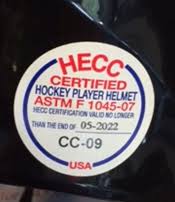Helmets
They are the most important piece of protective equipment in hockey. Even if you’re playing in “non-contact” adult league, there’s no guarantee that beer-belly Dave won’t start head hunting after you chirped him for missing the empty net.
Regardless of skill-level, all hockey players are at risk to receive a head injury, but the likelihood of receiving a concussion is much higher for players who don’t wear a protective helmet that fits well.
Some things to look for when you pick a helmet:
- Approval from the HECC, CSA, and CE: You should be able to notice their labels on the back of the helmet. If it’s a safe, quality bucket, there is no reason it shouldn’t have the approval.

- Made by Bauer, CCM, Reebok, or Easton: This doesn’t mean helmets manufactured by other companies aren’t as protective, but these four producers are commonly known for making quality helmets for players at all levels.
Construction / Additional Features
All helmets have a shell, inner padding, and hardware to adjust and hold it in place. Many buckets have a handful of additional features to increase safety and/or comfortability. Here’s a few things to look for:
- “Tool-less” adjusting latches eliminate the painstaking process of having to unscrew and re-screw bolts to modify your helmet. If your bucket happens to get knocked loose, you just need to open the back or side latches, adjust, and close.
- Occipital locks are dials located on the back of the helmet that cup the back of your head to prevent any loosening.
- High-density foam absorbs more shock than the padding in other helmets, decreasing the risk of head injuries.
EPP v. VN
EPP and VN are the two main categories of today’s hockey buckets. Neither has been proven as the more protective choice, but it’s good to know the differences.
- EPP (expanded polypropylene) has hard and soft foam for a comfortable and snug fit. They’re usually more expensive.
- VN (dual-density vinyl nitrile) have soft foam that molds to your head. They’re typically less expensive.
Face Protection
Every hockey player is at risk for the occasional puck or stick to the face. All youth, high school, and college players are required to wear a cage or full-shield, but even if your league doesn’t require masks, it’s never a bad idea to keep your face protected.
There are a handful of different masks to choose from, and there are pros and cons for each.
Cages
- PRO: most protective option
- PRO: low maintenance
- CON: have to look through wires
Full Shield / “Bubble”
- PRO: clear vision
- CON: can fog up or scratch
Half Shield / Visor
- PRO: clear vision, lightest option
- CON: leaves mouth and jaw exposed
Important things to note when buying a mask:
- If you wear a medium helmet, that doesn’t automatically mean you need a medium cage. Helmet size doesn’t always match with mask size.
- Most pro shops and websites have helmet and mask “combos,” that are cheaper than the cost of buying each separately.
Sizing
Your noggin isn’t safe if your helmet isn’t the right size. If it causes any pain, it’s too small, and if it wiggles around, it’s too big. The right helmet should provide a snug fit while still being comfortable to wear.
| Size | Hat Size | Head Circumference (in) |
| Small | 6.5 – 7 | 20.5 – 22 |
| Medium | 7 – 7.25 | 22 – 22.75 |
| Large | 7.25 – 7.5 | 22.75 – 23.63 |
| Extra-Large | 7.5 – 7.88 | 23.63 – 24.75 |
